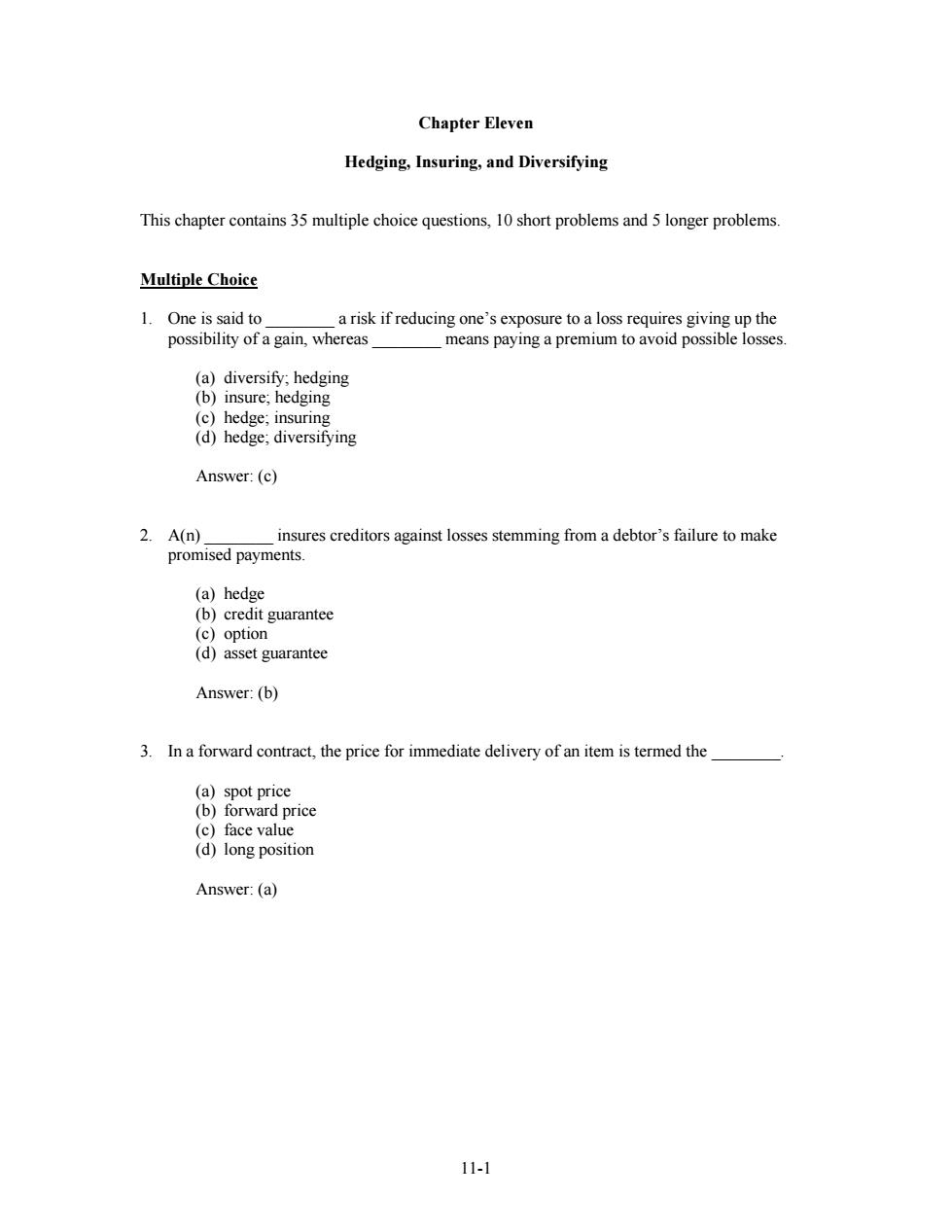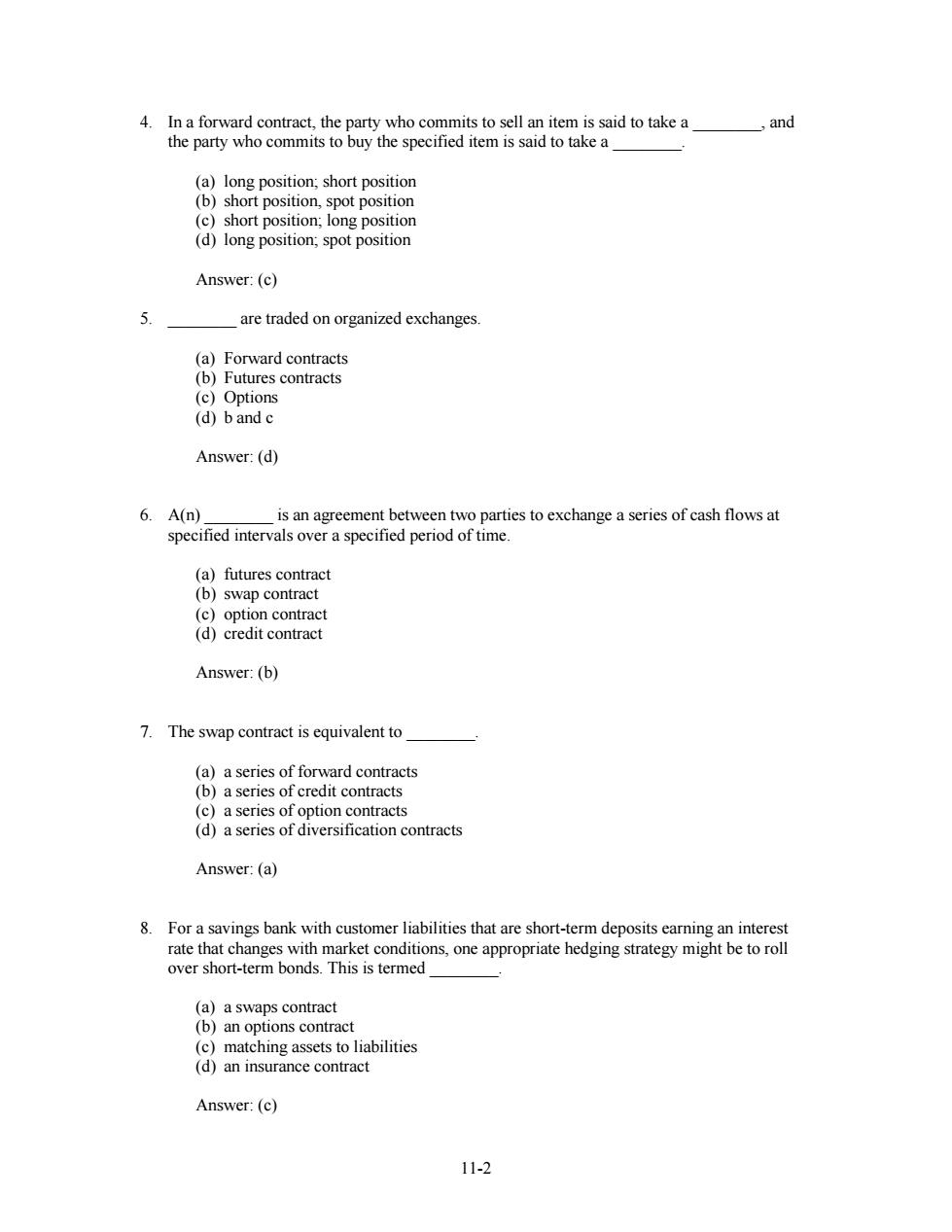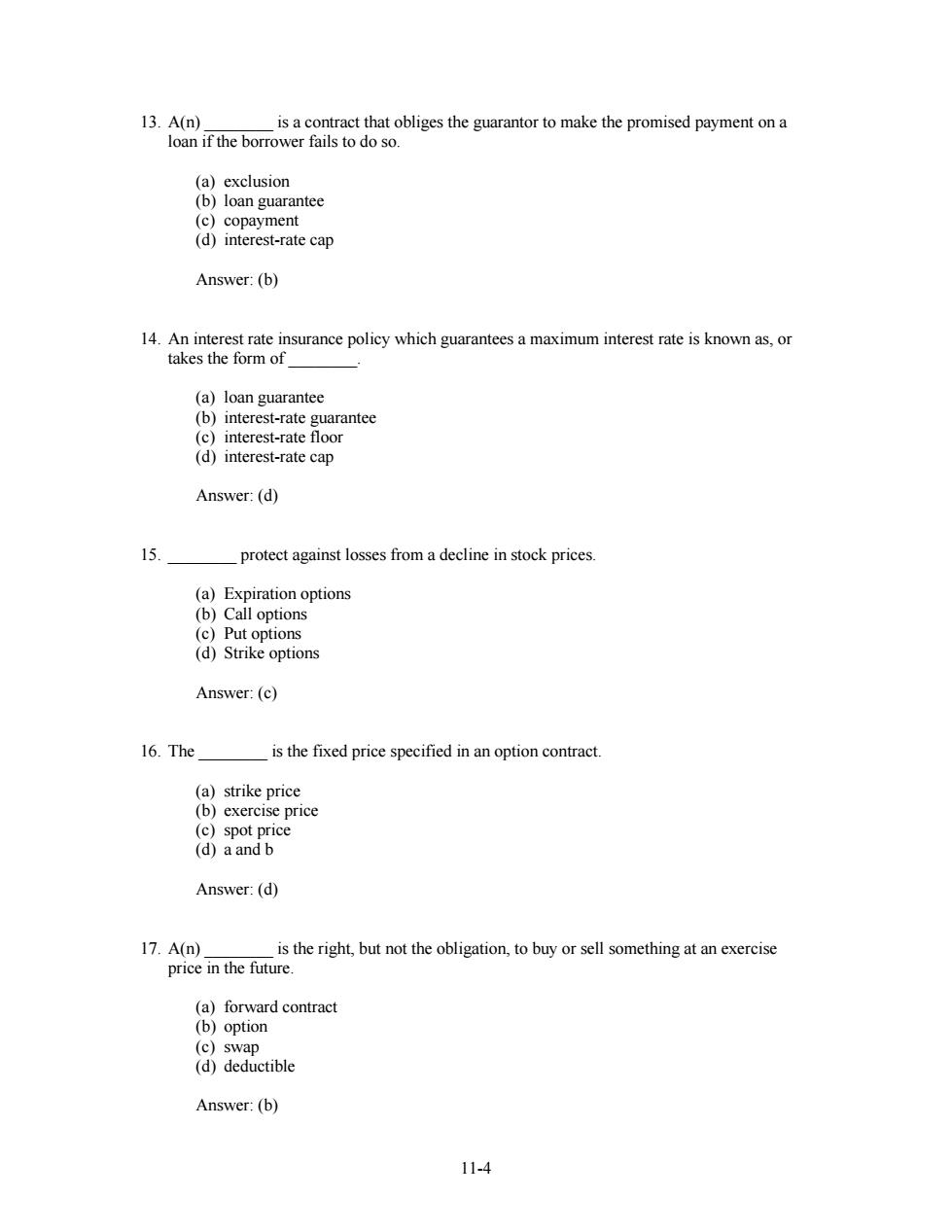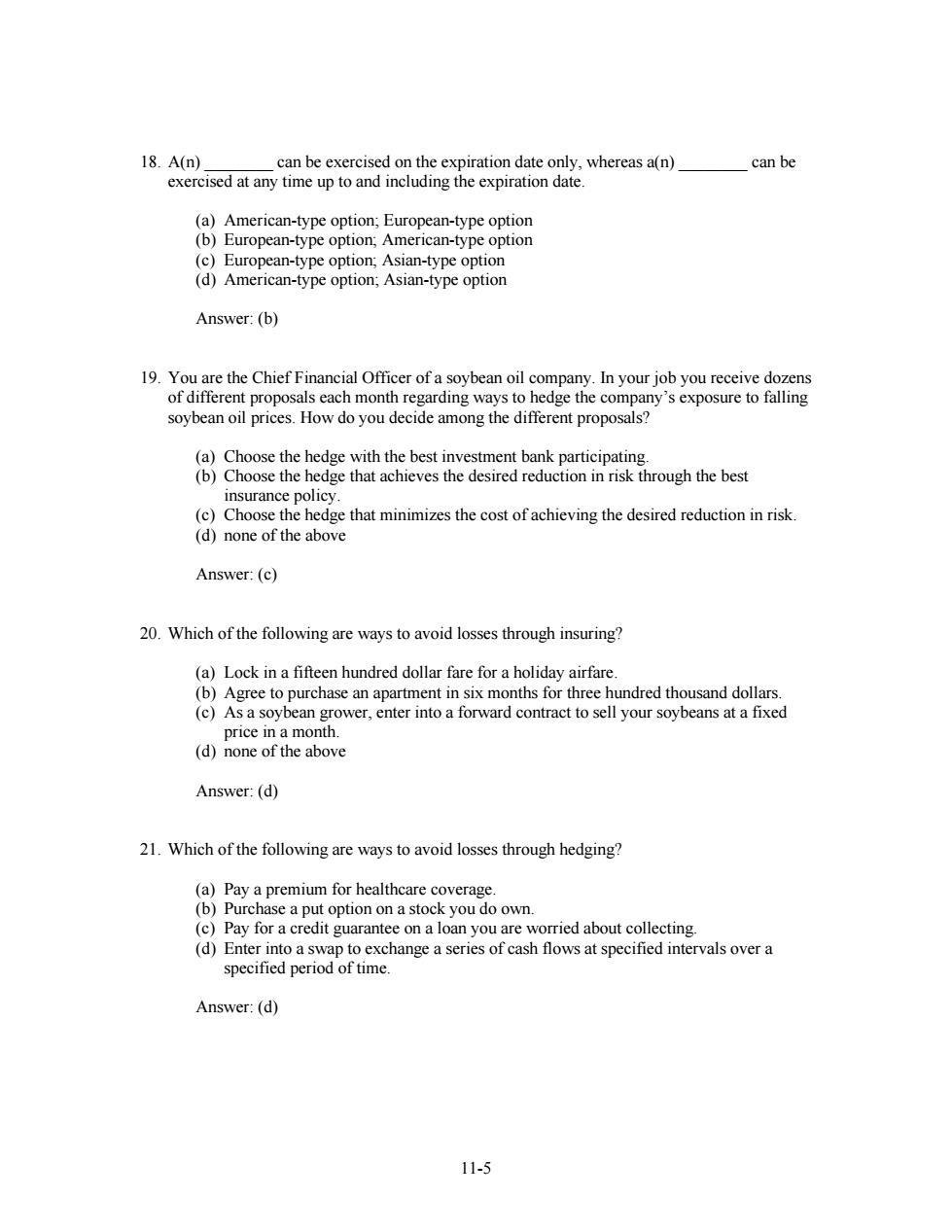
Chapter Eleven Hedging,Insuring,and Diversifying This chapter contains 35 multiple choice questions,10 short problems and 5 longer problems. Multiple Choice 1.One is said to a risk if reducing one's exposure to a loss requires giving up the possibility of a gain,whereas _means paying a premium to avoid possible losses. (a)diversify;hedging (b)insure;hedging (c)hedge;insuring (d)hedge;diversifying Answer:(c) 2.A(n) insures creditors against losses stemming from a debtor's failure to make promised payments. (a)hedge (b)credit guarantee (c)option (d)asset guarantee Answer:(b) 3.In a forward contract,the price for immediate delivery of an item is termed the (a)spot price (b)forward price (c)face value (d)long position Answer:(a) 11-1
11-1 Chapter Eleven Hedging, Insuring, and Diversifying This chapter contains 35 multiple choice questions, 10 short problems and 5 longer problems. Multiple Choice 1. One is said to ________ a risk if reducing one’s exposure to a loss requires giving up the possibility of a gain, whereas ________ means paying a premium to avoid possible losses. (a) diversify; hedging (b) insure; hedging (c) hedge; insuring (d) hedge; diversifying Answer: (c) 2. A(n) ________ insures creditors against losses stemming from a debtor’s failure to make promised payments. (a) hedge (b) credit guarantee (c) option (d) asset guarantee Answer: (b) 3. In a forward contract, the price for immediate delivery of an item is termed the ________. (a) spot price (b) forward price (c) face value (d) long position Answer: (a)

4.In a forward contract,the party who commits to sell an item is said to take a,and the party who commits to buy the specified item is said to take a (a)long position;short position (b)short position,spot position (c)short position;long position (d)long position;spot position Answer:(c) 5. are traded on organized exchanges. (a)Forward contracts (b)Futures contracts (c)Options (d)b and c Answer:(d) 6.A(n) is an agreement between two parties to exchange a series of cash flows at specified intervals over a specified period of time. (a)futures contract (b)swap contract (c)option contract (d)credit contract Answer:(b) 7.The swap contract is equivalent to (a)a series of forward contracts (b)a series of credit contracts (c)a series of option contracts (d)a series of diversification contracts Answer:(a) 8.For a savings bank with customer liabilities that are short-term deposits earning an interest rate that changes with market conditions,one appropriate hedging strategy might be to roll over short-term bonds.This is termed (a)a swaps contract (b)an options contract (c)matching assets to liabilities (d)an insurance contract Answer:(c) 11-2
11-2 4. In a forward contract, the party who commits to sell an item is said to take a ________, and the party who commits to buy the specified item is said to take a ________. (a) long position; short position (b) short position, spot position (c) short position; long position (d) long position; spot position Answer: (c) 5. ________ are traded on organized exchanges. (a) Forward contracts (b) Futures contracts (c) Options (d) b and c Answer: (d) 6. A(n) ________ is an agreement between two parties to exchange a series of cash flows at specified intervals over a specified period of time. (a) futures contract (b) swap contract (c) option contract (d) credit contract Answer: (b) 7. The swap contract is equivalent to ________. (a) a series of forward contracts (b) a series of credit contracts (c) a series of option contracts (d) a series of diversification contracts Answer: (a) 8. For a savings bank with customer liabilities that are short-term deposits earning an interest rate that changes with market conditions, one appropriate hedging strategy might be to roll over short-term bonds. This is termed ________. (a) a swaps contract (b) an options contract (c) matching assets to liabilities (d) an insurance contract Answer: (c)

9 are limits placed on compensation for particular losses covered under an insurance contract. (a)exclusions (b)caps (c)deductibles (d)copayments Answer:(b) 10.Life insurance policies pay benefits if an insured party dies,but such policies do not pay death benefits if the insured person takes his or her own life.This is known as a(n): (a)exclusion (b)cap (c)deductible (d)copayment Answer:(a) 11. create incentives for insured parties to control their losses,and represent the amount of money the insured party must pay out of his or her own resources before receiving any compensation from the insurer. (a)exclusions (b)caps (c)deductibles (d)loan guarantees Answer:(c) 12. means that the insured party must cover a fraction of the loss. (a)exclusions (b)caps (c)copayments (d)loan guarantees Answer:(c) 11-3
11-3 9. ________ are limits placed on compensation for particular losses covered under an insurance contract. (a) exclusions (b) caps (c) deductibles (d) copayments Answer: (b) 10. Life insurance policies pay benefits if an insured party dies, but such policies do not pay death benefits if the insured person takes his or her own life. This is known as a(n): (a) exclusion (b) cap (c) deductible (d) copayment Answer: (a) 11. ________ create incentives for insured parties to control their losses, and represent the amount of money the insured party must pay out of his or her own resources before receiving any compensation from the insurer. (a) exclusions (b) caps (c) deductibles (d) loan guarantees Answer: (c) 12. ________ means that the insured party must cover a fraction of the loss. (a) exclusions (b) caps (c) copayments (d) loan guarantees Answer: (c)

13.A(n) is a contract that obliges the guarantor to make the promised payment on a loan if the borrower fails to do so. (a)exclusion (b)loan guarantee (c)copayment (d)interest-rate cap Answer:(b) 14.An interest rate insurance policy which guarantees a maximum interest rate is known as,or takes the form of (a)loan guarantee (b)interest-rate guarantee (c)interest-rate floor (d)interest-rate cap Answer:(d) 15. protect against losses from a decline in stock prices. (a)Expiration options (b)Call options (c)Put options (d)Strike options Answer:(c) 16.The is the fixed price specified in an option contract. (a)strike price (b)exercise price (c)spot price (d)a and b Answer:(d) 17.A(n) is the right,but not the obligation,to buy or sell something at an exercise price in the future. (a)forward contract (b)option (c)swap (d)deductible Answer:(b) 11-4
11-4 13. A(n) ________ is a contract that obliges the guarantor to make the promised payment on a loan if the borrower fails to do so. (a) exclusion (b) loan guarantee (c) copayment (d) interest-rate cap Answer: (b) 14. An interest rate insurance policy which guarantees a maximum interest rate is known as, or takes the form of ________. (a) loan guarantee (b) interest-rate guarantee (c) interest-rate floor (d) interest-rate cap Answer: (d) 15. ________ protect against losses from a decline in stock prices. (a) Expiration options (b) Call options (c) Put options (d) Strike options Answer: (c) 16. The ________ is the fixed price specified in an option contract. (a) strike price (b) exercise price (c) spot price (d) a and b Answer: (d) 17. A(n) ________ is the right, but not the obligation, to buy or sell something at an exercise price in the future. (a) forward contract (b) option (c) swap (d) deductible Answer: (b)

18.A(n) can be exercised on the expiration date only,whereas a(n) can be exercised at any time up to and including the expiration date. (a)American-type option;European-type option (b)European-type option;American-type option (c)European-type option;Asian-type option (d)American-type option;Asian-type option Answer:(b) 19.You are the Chief Financial Officer of a soybean oil company.In your job you receive dozens of different proposals each month regarding ways to hedge the company's exposure to falling soybean oil prices.How do you decide among the different proposals? (a)Choose the hedge with the best investment bank participating. (b)Choose the hedge that achieves the desired reduction in risk through the best insurance policy. (c)Choose the hedge that minimizes the cost of achieving the desired reduction in risk. (d)none of the above Answer:(c) 20.Which of the following are ways to avoid losses through insuring? (a)Lock in a fifteen hundred dollar fare for a holiday airfare. (b)Agree to purchase an apartment in six months for three hundred thousand dollars. (c)As a soybean grower,enter into a forward contract to sell your soybeans at a fixed price in a month. (d)none of the above Answer:(d) 21.Which of the following are ways to avoid losses through hedging? (a)Pay a premium for healthcare coverage. (b)Purchase a put option on a stock you do own. (c)Pay for a credit guarantee on a loan you are worried about collecting. (d)Enter into a swap to exchange a series of cash flows at specified intervals over a specified period of time. Answer:(d) 11-5
11-5 18. A(n) ________ can be exercised on the expiration date only, whereas a(n) ________ can be exercised at any time up to and including the expiration date. (a) American-type option; European-type option (b) European-type option; American-type option (c) European-type option; Asian-type option (d) American-type option; Asian-type option Answer: (b) 19. You are the Chief Financial Officer of a soybean oil company. In your job you receive dozens of different proposals each month regarding ways to hedge the company’s exposure to falling soybean oil prices. How do you decide among the different proposals? (a) Choose the hedge with the best investment bank participating. (b) Choose the hedge that achieves the desired reduction in risk through the best insurance policy. (c) Choose the hedge that minimizes the cost of achieving the desired reduction in risk. (d) none of the above Answer: (c) 20. Which of the following are ways to avoid losses through insuring? (a) Lock in a fifteen hundred dollar fare for a holiday airfare. (b) Agree to purchase an apartment in six months for three hundred thousand dollars. (c) As a soybean grower, enter into a forward contract to sell your soybeans at a fixed price in a month. (d) none of the above Answer: (d) 21. Which of the following are ways to avoid losses through hedging? (a) Pay a premium for healthcare coverage. (b) Purchase a put option on a stock you do own. (c) Pay for a credit guarantee on a loan you are worried about collecting. (d) Enter into a swap to exchange a series of cash flows at specified intervals over a specified period of time. Answer: (d)